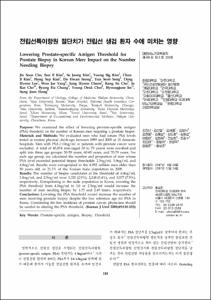전립선특이항원 절단치가 전립선 생검 환자 수에 미치는 영향
- Keimyung Author(s)
- Kim, Chun Il
- Department
- Dept. of Urology (비뇨의학)
- Journal Title
- Korean Journal of Urology
- Issued Date
- 2008
- Volume
- 49
- Issue
- 2
- Keyword
- Prostate-specific antigen; Biopsy; Threshold
- Abstract
- Purpose: We examined the effect of lowering prostate-specific antigen (PSA) threshold on the number of Korean men requiring a prostate biopsy. Materials and Methods: We evaluated men who had serum PSA levels tested at routine physical check-ups between 1999 and 2005 at 11 domestic hospitals. Men with PSA≥10ng/ml or patients with prostate cancer were excluded. A total of 45,074 men (aged 50 to 79 years) were enrolled and split into three age groups: 50-59 years, 60-69 years, and 70-79 years. For each age group, we calculated the number and proportion of men whose PSA level exceeded potential biopsy thresholds: 2.5ng/ml, 3.0ng/ml, and 4.0ng/ml. Results were extrapolated to the 4.992 million men older than 50 years old, or 21.3% of the Korean male population in 2005. Results: The number of biopsy candidates at the threshold of 4.0ng/ml, 3.0ng/ml, and 2.5ng/ml were 1,321 (2.9%), 2,248 (5.4%), and 3,577 (7.9%), respectively. Extrapolating to the male population in Korea, lowering the PSA threshold from 4.0ng/ml to 3.0 or 2.5ng/ml would increase the number of men needing biopsy by 1.75 and 2.49 times, respectively. Conclusions: Lowering the PSA threshold would increase the number of men receiving prostate biopsy despite the low reference age for PSA in Korea. Considering the low incidence of prostate cancer, physicians should be careful in altering the PSA threshold.
- Alternative Title
- Lowering Prostate-specific Antigen Threshold for Prostate Biopsy in Korean Men: Impact on the Number Needing Biopsy
- Keimyung Author(s)(Kor)
- 김천일
- Publisher
- School of Medicine
- Citation
- 조진선 et al. (2008). 전립선특이항원 절단치가 전립선 생검 환자 수에 미치는 영향. Korean Journal of Urology, 49(2), 118–121. doi: 10.4111/kju.2008.49.2.118
- Type
- Article
- ISSN
- 0494-4747
- Appears in Collections:
- 1. School of Medicine (의과대학) > Dept. of Urology (비뇨의학)
- 파일 목록
-
-
Download
 oak-aaa-03619.pdf
기타 데이터 / 610.29 kB / Adobe PDF
oak-aaa-03619.pdf
기타 데이터 / 610.29 kB / Adobe PDF
-
Items in Repository are protected by copyright, with all rights reserved, unless otherwise indicated.